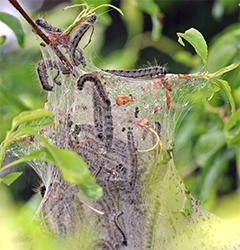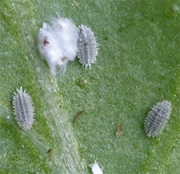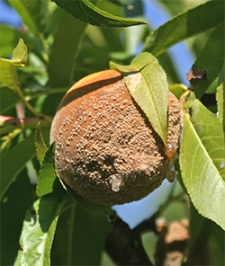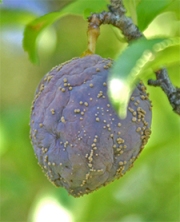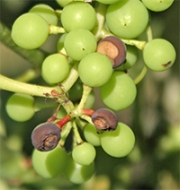Just yesterday on my way to work, I noticed some very tiny tent caterpillar nests beginning to form in the cherry trees along the side of the road. They seem to be a little later this spring which fits with the slightly later spring we are experiencing this year. Seeing them reminded me of the blog post I wrote back in early April of 2010 and I thought it would be appropriate to re-run this post to remind folks that NOW is the time to attack these icky, squiggly caterpillars – BEFORE they do major damage to your beautiful landscape trees.
So, here you go (with a few added tips) …
Well, it’s that time of year again!
I saw the tell-tale signs on the way to the nursery yesterday – the beginnings of the familiar, yet dreaded tent caterpillar webs starting to form in the crotches of the small cherries at the side of the road. Today, they’re even bigger! Everyday they will grow … little webs will grow into bigger webs; little caterpillars will grow into big leaf-eating machines crawling over the branches devouring every bit of green foliage on the tree until it looks like winter has returned!
Nasty little critters! I know they must serve some purpose in the greater scheme of things but I sure haven’t figured out what that might be – food for the birds, I suppose. Yes, I’m sure that must be why they exist!
Well, what can you do about them? “Knock ’em out while they are small”, Andre always says. It’s the best time and you don’t have to resort to using chemical insecticides.
Wage biological warfare!! When they are small, they can be eradicated with a lovely little bacterium called Bt (short for Bacillus thuringiensis). Bt (also sold under the trade name Dipel) produces a natural insecticide and has been used by organic farmers for years to safely control many insect pests. Just spray it on the foliage and when the caterpillar eats the leaves, they ingest the Bt which produces a toxin that basically dissolves their gut and kills them within a few days – no harm to the environment or beneficial insects!
And … even though it takes a few days for the caterpillars to die, the best part is that they stop eating within a few hours so your trees are saved from defoliation! Good stuff – and environmentally responsible, too!
Look for Bonide Thuricide (BT) Liquid Concentrate or Dipel; they should be right on the shelf of your full service garden store.
Though Bt works best on the very young caterpillars, all is not lost if you miss this stage and suddenly find that you have the larger caterpillars crawling all over your trees devouring every last leaf they can find. These larger caterpillars can be controlled using Bonide Captain Jack’s Deadbug Brew according to the label directions. Captain Jack’s Deadbug Brew is a natural but effective, broad-spectrum ORGANIC insect control which is listed for controlling tent caterpillars as well as many other insect pests on both ornamental and edible crops.
NEVER spray any insecticide when trees are in bloom!
Don’t want to spray? Watch this Viette video tip for another interesting way to get rid of tent caterpillars! Along this line, my husband will poke a stick into the web and wind the web, caterpillars and all, up on the end of the stick and then stomp them into the ground! Ahhhhh – revenge is sweet!
Another way to get rid of tent caterpillars is to break their life cycle by destroying their egg masses before they hatch. These egg masses are found encircling the tips of small branches of host trees from July – February. Some of their favorite trees are cherries, crabapples, and apples. Sometimes you can prune off the branch tips containing egg cases but a more effective way to destroy the eggs is to spray the trees thoroughly with a horticultural oil such as Bonide All Seasons Oil to smother and kill the eggs. If you have tent caterpillars this spring, put a reminder in your gardening calendar for a late fall and/or late winter spraying with horticultural oil. This will also help control many other insect pests that overwinter in your garden!
Read more about the benefits of horticultural oil.
So …
Keep an eye peeled for these tent caterpillar nests in your trees and be ready to do battle while the caterpillars are young and vulnerable.
Until next time – Happy Gardening!



